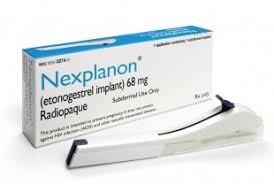Etonogestrel Side Effects
Medically reviewed by Drugs.com. Last updated on Aug 19, 2023.
Applies to etonogestrel: subcutaneous implant.
Serious side effects of Etonogestrel
WARNING/CAUTION: Even though it may be rare, some people may have very bad and sometimes deadly side effects when taking a drug. Tell your doctor or get medical help right away if you have any of the following signs or symptoms that may be related to a very bad side effect:
- Signs of an allergic reaction, like rash; hives; itching; red, swollen, blistered, or peeling skin with or without fever; wheezing; tightness in the chest or throat; trouble breathing, swallowing, or talking; unusual hoarseness; or swelling of the mouth, face, lips, tongue, or throat.
- Signs of liver problems like dark urine, feeling tired, not hungry, upset stomach or stomach pain, light-colored stools, throwing up, or yellow skin or eyes.
- Signs of high blood pressure like very bad headache or dizziness, passing out, or change in eyesight.
- Signs of gallbladder problems like pain in the upper right belly area, right shoulder area, or between the shoulder blades; yellow skin or eyes; fever with chills; bloating; or very upset stomach or throwing up.
- Signs of skin infection like oozing, heat, swelling, redness, or pain.
- Weakness on 1 side of the body, trouble speaking or thinking, change in balance, drooping on one side of the face, or blurred eyesight.
- Depression or other mood changes.
- Eyesight changes or loss, bulging eyes, or change in how contact lenses feel.
- A lump in the breast, breast pain or soreness, or nipple discharge.
- Flu-like signs.
- Vaginal bleeding that is not normal.
- This drug may cause you to swell or keep fluid in your body. Tell your doctor if you have swelling, weight gain, or trouble breathing.
Other side effects of Etonogestrel
All drugs may cause side effects. However, many people have no side effects or only have minor side effects. Call your doctor or get medical help if any of these side effects or any other side effects bother you or do not go away:
- Weight gain.
- Dizziness or headache.
- Pimples (acne).
- Vaginal irritation.
- Period (menstrual) changes. These include spotting between cycles or very light periods.
- Irritation where rod was placed.
- Stomach pain.
- Throat irritation.
- Back pain.
- Upset stomach.
- Feeling nervous and excitable.
These are not all of the side effects that may occur. If you have questions about side effects, call your doctor. Call your doctor for medical advice about side effects.
You may report side effects to the FDA at 1-800-332-1088. You may also report side effects at https://www.fda.gov/medwatch.
For Healthcare Professionals
Applies to etonogestrel: subcutaneous implant.
Genitourinary
Very common (10% or more): Menstrual bleeding irregularities (37%), vaginitis (14.5%), breast pain (12.8%)
Common (1% to 10%): Leukorrhea, dysmenorrhea
Uncommon (0.1% to 1%): Urinary tract infection, dysuria, genital discharge, vulvovaginal discomfort, galactorrhea, breast enlargement, pruritus genital
Postmarketing reports: Ectopic pregnancy, breast discharge, ovarian cyst[Ref]
Nervous system
Very common (10% or more): Headache (24.9%)
Common (1% to 10%): Dizziness
Uncommon (0.1% to 1%): Migraine, somnolence
Postmarketing reports: Convulsions[Ref]
Metabolic
Very common (10% or more): Weight increase (13.7%)
Common (1% to 10%): Increased appetite, weight decreased[Ref]
Dermatologic
Very common (10% or more): Acne (14.8%)
Common (1% to 10%): Alopecia
Uncommon (0.1% to 1%): Hypertrichosis, pruritus, rash
Postmarketing reports: Angioedema, aggravation of angioedema and/or aggravation of hereditary angioedema, chloasma, seborrhea, urticaria[Ref]
Gastrointestinal
Very common (10% or more): Abdominal pain (10.9%)
Common (1% to 10%): Nausea, flatulence
Uncommon (0.1% to 1%): Constipation, diarrhea, vomiting[Ref]
Respiratory
Very common (10% or more): Pharyngitis (10.5%)
Postmarketing reports: Rhinitis[Ref]
Local
Implant site complications include: bruising, slight local irritation, pain, itching, fibrosis at implant site, paresthesia or paresthesia-like events, scarring, hematoma, redness, swelling, and abscess.
Migration of the implants has rarely occurred to the chest wall, as well as within the vasculature including the pulmonary artery. Some patients with migration to the pulmonary artery reported chest pain and/or dyspnea, others were asymptomatic.[Ref]
Common (1% to 10%): Insertion site pain, implant site complications, injection site reaction
Frequency not reported: Expulsion or migration of the implant[Ref]
Psychiatric
Common (1% to 10%): Emotional lability, depression, nervousness, libido decreased
Uncommon (0.1% to 1%): Anxiety, insomnia[Ref]
Musculoskeletal
Common (1% to 10%): Back pain
Uncommon (0.1% to 1%): Arthralgia, musculoskeletal pain, myalgia[Ref]
Hypersensitivity
Common (1% to 10%): Hypersensitivity
Postmarketing reports: Anaphylactic reactions[Ref]
Other
Common (1% to 10%): Influenza-like symptoms, pain, hot flush, fatigue
Uncommon (0.1% to 1%): Edema, pyrexia[Ref]
Cardiovascular
Postmarketing reports: Clinically relevant rise in blood pressure[Ref]
More about etonogestrel
- Check interactions
- Compare alternatives
- Reviews (6,570)
- Dosage information
- During pregnancy
- Drug class: contraceptives
- Breastfeeding
- En español
Patient resources
Other brands
Professional resources
Other brands
Related treatment guides
References
1. Cerner Multum, Inc. UK Summary of Product Characteristics.
2. Product Information. Implanon (etonogestrel). Organon Pharmaceuticals. 2006.
3. Cerner Multum, Inc. Australian Product Information.
4. Product Information. Nexplanon (etonogestrel). Organon Pharmaceuticals. 2017.
Further information
Always consult your healthcare provider to ensure the information displayed on this page applies to your personal circumstances.
Some side effects may not be reported. You may report them to the FDA.

